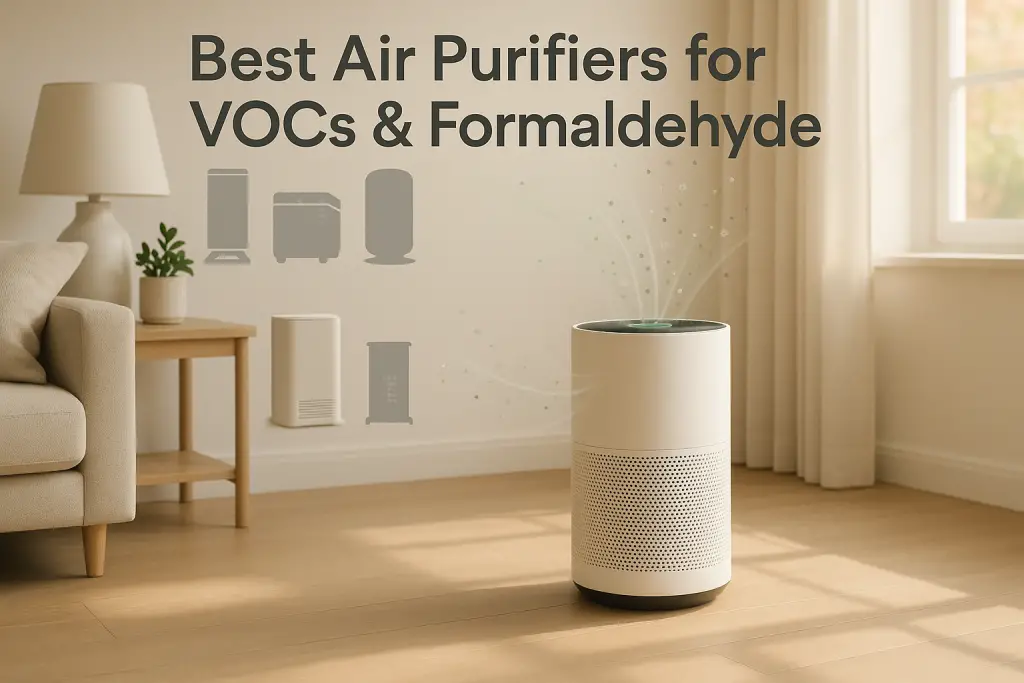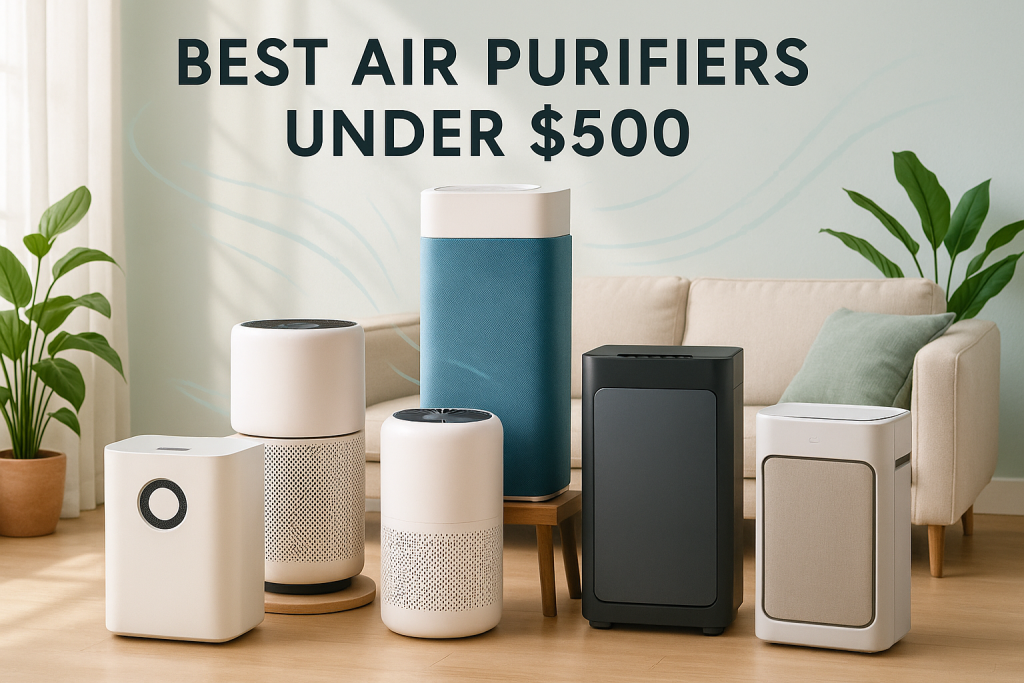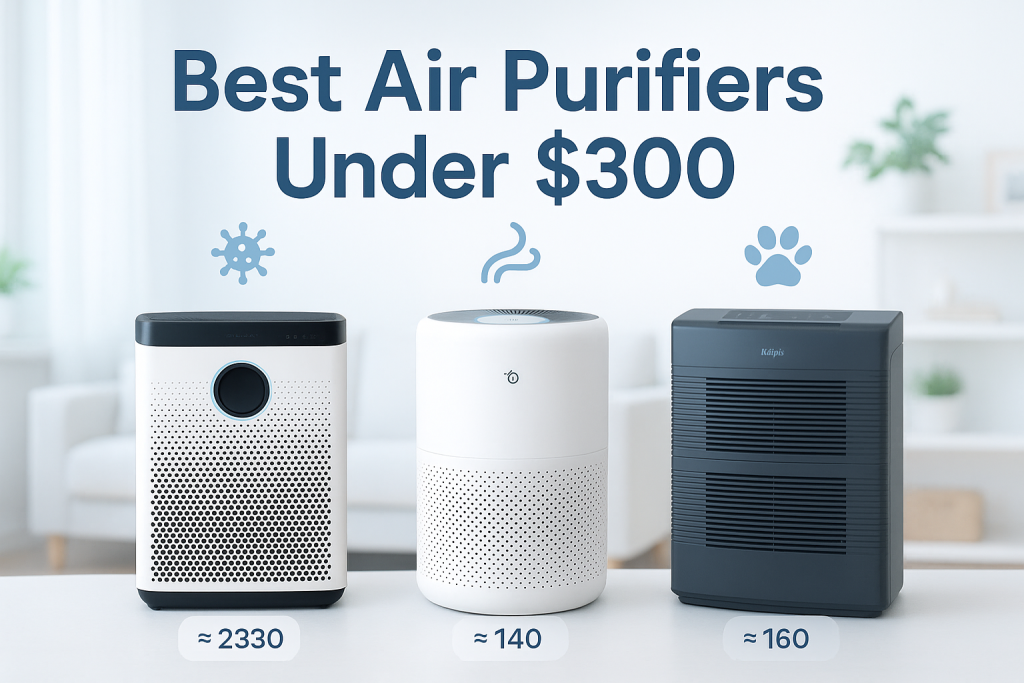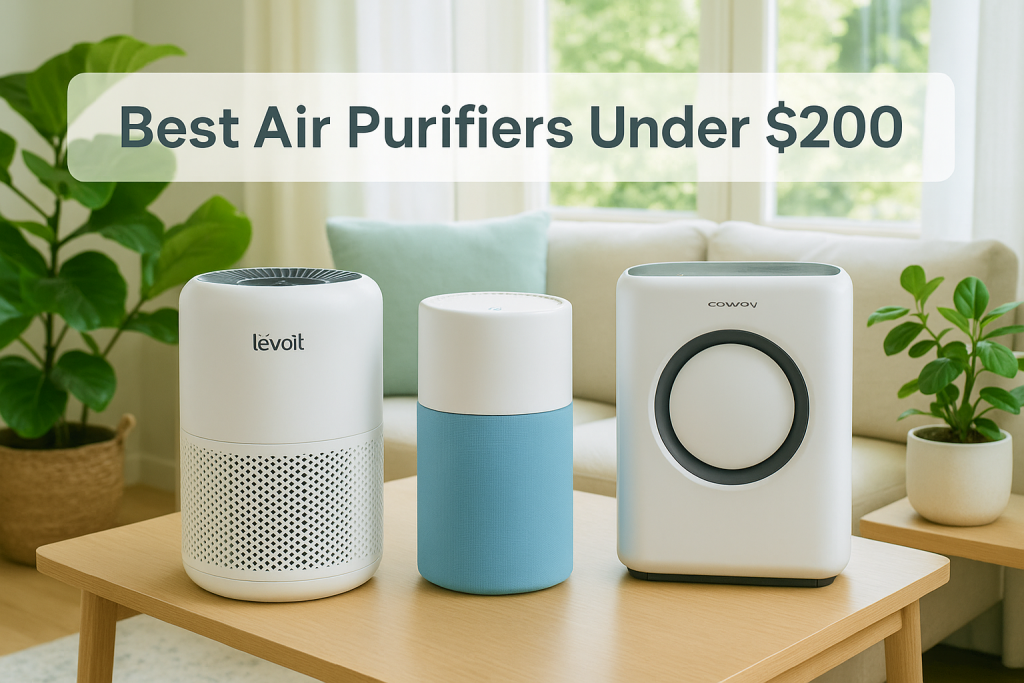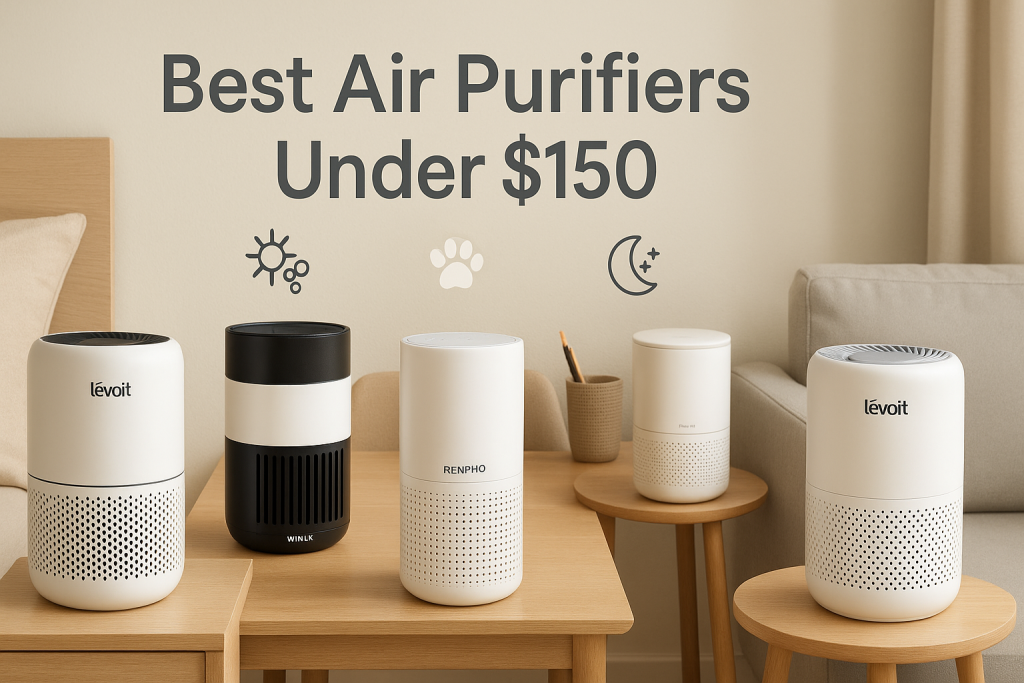Volatile Organic Compounds (VOCs) and formaldehyde present serious indoor air quality concerns that standard air purifiers often can’t handle effectively. The best air purifiers for VOCs and formaldehyde use specialized filtration technology designed specifically to capture these harmful chemicals. This guide examines top-performing models that effectively remove these invisible pollutants, improving your home’s air quality and protecting your family’s health.
Understanding VOCs and Formaldehyde in Your Home
Volatile Organic Compounds (VOCs) and formaldehyde are invisible chemicals that vaporize at room temperature, potentially causing both immediate and long-term health effects. Before selecting an air purifier, it’s essential to understand what these chemicals are, where they come from, and how they affect your health.
VOCs include a wide range of chemicals like benzene, toluene, xylene, and ethylene glycol that easily become vapors or gases. Formaldehyde is particularly concerning as a common VOC found in many household products and building materials. According to the EPA, indoor VOC levels can be up to 10 times higher than outdoor levels.
Common sources of VOCs and formaldehyde in homes include:
- New furniture (especially pressed wood products)
- Fresh paint and varnishes
- New flooring, particularly laminate and vinyl
- Cleaning products and air fresheners
- Cigarette smoke
- Craft supplies (glues, markers, etc.)
- Dry-cleaned clothing
Health effects from VOC exposure range from minor irritations to serious conditions:
- Short-term: Eye, nose, and throat irritation, headaches, dizziness, nausea
- Long-term: Liver and kidney damage, central nervous system damage, possible increased cancer risk
Unlike larger particulates that HEPA filters trap effectively, VOCs consist of microscopic molecules that pass straight through standard filters. This is why specialized filtration technology is essential for removing these harmful chemicals from your air.
How to Know if You Have VOC Problems
While VOCs are invisible and often odorless, there are several indicators that your home may have elevated VOC levels requiring intervention.
Watch for these warning signs:
- Physical symptoms: Headaches, dizziness, eye irritation, or respiratory issues that improve when you leave home
- New products or renovations: Recently painted rooms, new furniture, flooring, or cabinets
- Strong odors: Chemical smells from new items or cleaning products
- Lack of ventilation: Tightly sealed homes with limited fresh air exchange
For confirmation, consider these testing options:
- Consumer VOC monitors: Devices like the Airthings Wave Plus or uHoo provide real-time VOC level readings
- Professional testing: Home air quality tests from certified professionals offer comprehensive analysis
- DIY test kits: Mail-in test kits provide basic screening for major VOCs
Typical VOC levels are measured in parts per billion (ppb) or mg/m³. The EPA considers levels below 500 ppb acceptable, though sensitive individuals may react to much lower concentrations.
The Science of VOC and Formaldehyde Removal
Different air purifier technologies interact with VOCs and formaldehyde in distinct ways, which directly impacts their effectiveness at removing these chemicals from your air.
The primary methods for capturing VOCs include:
- Adsorption: Chemicals stick to the surface of a filtering material (like activated carbon)
- Absorption: Chemicals are trapped within the structure of a filtering material
- Catalytic oxidation: Chemicals are broken down into harmless components
Activated carbon is the most common and effective VOC filter material. Its microscopic porous structure provides massive surface area – just one gram can have over 3,000 square meters of surface area. VOCs and odor molecules become trapped in these tiny pores through a process called adsorption.
For formaldehyde specifically, specialized media like potassium permanganate, zeolite, or chemically treated activated carbon are required. Effective formaldehyde purification requires dedicated filter media since this chemical is particularly difficult to capture due to its small molecular size.
Newer technologies for VOC removal include:
- PECO (Photo Electrochemical Oxidation): Uses light-activated nanocatalyst to destroy VOCs
- Photocatalytic oxidation: Uses UV light and titanium dioxide to break down chemicals
- Molecular converters: Transform VOCs into harmless compounds through chemical reactions
How We Evaluated Air Purifiers for VOC Removal
Finding truly effective air purifiers for VOC and formaldehyde removal requires looking beyond marketing claims and CADR ratings. Our evaluation methodology prioritizes real-world effectiveness through multiple criteria.
Key factors we assessed include:
- Filter technology and media quality: We evaluated the type, quality, and quantity of activated carbon and specialized media for formaldehyde removal.
- Carbon amount and quality: More carbon generally means better VOC absorption and longer filter life. We prioritized units with substantial carbon filters (measured in pounds).
- Specialized formaldehyde filtration: We looked for dedicated media like potassium permanganate or treated carbon for formaldehyde removal.
- Air exchange rates: How quickly the unit processes the room’s air, measured in air changes per hour (ACH).
- Room coverage: Effective square footage based on ceiling height and air exchange rate.
- Filter replacement costs: Total cost of ownership including replacement filters over time.
- Noise levels: Decibel ratings at effective operational speeds.
- Energy consumption: Watts used at different settings, important for 24/7 operation.
- Smart features: VOC/formaldehyde sensors, auto modes, and air quality reporting.
We combined manufacturer specifications with independent testing data and user experiences to ensure our recommendations reflect real-world performance.
Best Overall Air Purifiers for VOC and Formaldehyde Removal
After extensive research and analysis, these air purifiers represent the most effective options for comprehensive VOC and formaldehyde removal, balancing performance, features, and value.
1. IQAir HealthPro Plus
The IQAir HealthPro Plus stands as the gold standard for VOC and formaldehyde removal, featuring an impressive 5 pounds of activated carbon blended with alumina and potassium permanganate in its V5-Cell filter.
Specifications:
- Coverage area: Up to 1,125 sq ft
- VOC filter: HyperHEPA filter + V5-Cell gas & odor filter
- Carbon amount: 5 lbs activated carbon with additives
- CADR: 300 cfm
- Filter lifespan: PreMax filter (18 months), V5-Cell (2 years), HyperHEPA (4 years)
- Noise level: 25-69 dB
- Price range: $899-$999
Pros:
- Exceptional VOC and formaldehyde removal capability
- Long filter life reduces maintenance frequency
- Swiss precision engineering for reliability
- Very quiet operation at lower speeds
- 360° air intake for efficient room coverage
Cons:
- Premium price point
- Significant size and weight
- No smart features or air quality sensors
- Higher energy consumption than some competitors
2. Austin Air HealthMate Plus
The Austin Air HealthMate Plus is purpose-built for chemical sensitivity with an incredible 15 pounds of activated carbon blended with zeolite for enhanced formaldehyde capture.
Specifications:
- Coverage area: Up to 1,500 sq ft
- VOC filter: 15 lbs activated carbon + zeolite
- CADR: 400 cfm
- Filter lifespan: 5 years
- Noise level: 40-65 dB
- Price range: $715-$845
Pros:
- Highest carbon content on the market
- Exceptional at removing complex VOC mixtures
- 5-year filter life (industry-leading)
- Medical-grade construction
- Made in USA with 5-year warranty
Cons:
- No smart features or air quality monitoring
- Fairly loud at higher speeds
- Heavy and utilitarian design
- No carrying handle despite weight
3. Blueair HealthProtect 7470i
The Blueair HealthProtect combines HEPASilent Ultra technology with substantial carbon filtration and smart features for effective VOC removal with modern convenience.
Specifications:
- Coverage area: Up to 418 sq ft (5 air changes/hour)
- VOC filter: Activated carbon + electrostatic filtration
- CADR: 270 cfm (smoke)
- Filter lifespan: 6-8 months
- Noise level: 25-53 dB
- Price range: $769-$839
Pros:
- Excellent VOC sensor technology
- Exceptionally quiet operation
- Smart functionality with app control
- Real-time air quality feedback
- Modern design that blends with decor
Cons:
- Higher filter replacement costs
- Less carbon than specialized VOC units
- Coverage area smaller than competitors
Best Budget Air Purifiers for VOC Removal
Effective VOC removal typically requires more expensive technology, but these budget-friendly options provide meaningful chemical reduction at more accessible price points.
1. Levoit Core 300S with Toxin Absorber Filter
The Levoit Core 300S with the specialized Toxin Absorber Filter offers targeted VOC removal at an affordable price point.
Specifications:
- Coverage area: Up to 219 sq ft (5 air changes/hour)
- VOC filter: H13 HEPA + activated carbon pellets in Toxin Absorber Filter
- CADR: 141 cfm
- Filter lifespan: 6-8 months
- Noise level: 24-50 dB
- Price range: $99-$149 + specialized filter ($40)
Pros:
- Affordable entry point for VOC filtration
- Specialized Toxin Absorber Filter option
- Very quiet operation
- Compact design for small spaces
- Smart features via app
Cons:
- Limited carbon quantity compared to premium models
- Smaller coverage area
- Less effective for severe VOC issues
- More frequent filter replacements
2. Winix 5500-2
The Winix 5500-2 combines washable carbon pre-filters with PlasmaWave technology for a budget-friendly approach to VOC reduction.
Specifications:
- Coverage area: Up to 360 sq ft
- VOC filter: Washable carbon pre-filter + HEPA
- CADR: 243 cfm (smoke)
- Filter lifespan: Carbon pre-filter (3 months, washable), HEPA (12 months)
- Noise level: 27-60 dB
- Price range: $159-$199
Pros:
- Good value for coverage area
- Washable pre-filter reduces costs
- Air quality sensor with auto mode
- PlasmaWave helps break down some VOCs
Cons:
- Limited carbon quantity for serious VOC issues
- Not specialized for formaldehyde
- PlasmaWave technology controversial for some users
To maximize effectiveness of budget options:
- Place the unit closer to VOC sources
- Run at higher speeds initially when VOC levels spike
- Replace filters more frequently than recommended
- Use multiple units for larger spaces
- Combine with increased ventilation when possible
Best Air Purifiers for Specific VOC Concerns
Different sources of VOCs may require specialized approaches. These purifiers excel at addressing specific VOC challenges that many homeowners face.
For New Construction and Renovations
Airpura R600
Specifically designed for renovation scenarios with 18 pounds of activated carbon for capturing paint fumes, carpet off-gassing, and construction adhesives.
Key features:
- 18 lbs of activated carbon
- Coverage up to 2,000 sq ft
- Variable speed control
- Specialized for chemical and gas removal
- Price range: $699-$799
For basement renovations where VOCs can concentrate due to poor ventilation, the Airpura R600 provides exceptional chemical filtration capacity in a portable unit.
For New Furniture Off-Gassing
Molekule Air Pro
Uses PECO technology to destroy VOCs rather than just trapping them, making it effective for the complex chemical mixtures in new furniture.
Key features:
- PECO destruction technology
- Coverage up to 1,000 sq ft
- Particle and VOC sensors
- App control with detailed reporting
- Price range: $999-$1,199
For Chemical Sensitivities and Allergies
AllerAir AirMedic Pro 5 MG
Designed specifically for people with multiple chemical sensitivities and severe allergies requiring advanced air purification.
Key features:
- Medical-grade HEPA filtration
- 8 lbs of activated carbon blend
- Metal housing with powder coat finish (no off-gassing)
- Optional UV sterilization
- Price range: $849-$949
For Small Spaces and Apartments
Rabbit Air MinusA2 Ultra Quiet
Wall-mountable design perfect for apartments with customizable filter options for specific VOC concerns.
Key features:
- Six-stage filtration including custom filters
- Coverage up to 815 sq ft
- Wall-mountable design saves floor space
- Exceptionally quiet (25.6-51.3 dB)
- Price range: $549-$599
For best results in each scenario:
- Place units near the primary VOC source
- Run at higher speeds during peak off-gassing periods
- Create a “clean room” focusing on bedrooms first
- Combine with source control (sealing, covering, or removing offending items)
Air Purifiers for Formaldehyde-Specific Concerns
Formaldehyde presents unique challenges for filtration due to its small molecular size and persistent nature. These purifiers are specifically designed to target formaldehyde through specialized media and advanced technologies.
Formaldehyde (HCHO) has a molecular size of just 0.001 microns, making it extremely difficult for standard carbon filters to trap effectively. It’s also continuously released from sources for years, creating an ongoing challenge.
Austin Air HealthMate+ Jr.
Features a specialized carbon blend with potassium iodide specifically formulated for formaldehyde and other aldehydes.
Key features:
- 5 lbs of carbon with potassium iodide
- Smaller footprint than standard HealthMate+
- Coverage up to 700 sq ft
- 5-year filter life
- Price range: $415-$455
Coway Airmega 400S
Features a dual carbon + HEPA filter system and performs exceptionally well for formaldehyde in independent testing.
Key features:
- Dual filtration system with substantial carbon
- Smart sensing technology
- Coverage up to 1,560 sq ft
- Real-time air quality monitoring
- Price range: $649-$699
For enhanced formaldehyde reduction:
- Maintain indoor temperature below 78°F when possible (reduces off-gassing)
- Keep humidity between 30-50% (reduces formaldehyde release)
- Use multiple targeted units rather than one large unit
- Consider supplementing with formaldehyde-absorbing materials like houseplants
Air Purifier Technology Comparison for VOC Removal
Not all air purifier technologies are equally effective at removing VOCs and formaldehyde. This comparison explains the strengths and limitations of each approach to help you make an informed decision.
| Technology | VOC Effectiveness | Formaldehyde Specific | Replacement Needs | Best Applications |
|---|---|---|---|---|
| Activated Carbon (Granular) | High | Moderate | 6-12 months | General VOCs, odors |
| Activated Carbon (Pelletized) | Very High | Moderate | 12-24 months | Concentrated VOCs |
| Impregnated Carbon | High | High | 12-18 months | Formaldehyde, aldehydes |
| Zeolite | Moderate | High | 12-24 months | Formaldehyde, ammonia |
| Potassium Permanganate | Moderate | Very High | 12-18 months | Formaldehyde specific |
| PECO Technology | High | High | 6 months (filter), 1 year (bulb) | Breaking down chemicals |
| Photocatalytic Oxidation | Moderate | Moderate | 12-24 months (bulb) | Supplemental VOC reduction |
| Ionization/Plasma | Low-Moderate | Low | Minimal | Supplemental, not primary |
| Ozone Generators | Variable | Low | Minimal | NOT RECOMMENDED |
| HEPA Only | None | None | 6-12 months | HEPA filters alone cannot remove VOCs |
Activated Carbon: The gold standard for VOC removal, with effectiveness directly related to quantity and quality. Pelletized carbon provides more surface area than granular.
Specialized Media: Materials like zeolite, alumina, and potassium permanganate target specific chemicals that carbon alone might miss.
PECO Technology: Uses light-activated nanocatalyst to destroy VOCs rather than just trapping them. Effective but requires regular filter and bulb replacement.
Photocatalytic Oxidation: Uses UV light with titanium dioxide to break down some VOCs, but effectiveness varies widely between models.
Ionization/Plasma: Creates charged particles that can help break down some VOCs, but generally less effective than adsorption methods.
Ozone Generators: Not recommended for occupied spaces as ozone itself is a lung irritant. Can create secondary pollutants through chemical reactions.
Practical Guide: Using Air Purifiers Effectively for VOC Removal
Purchasing an effective air purifier is only the first step. Proper placement, settings, and maintenance are crucial for maximizing VOC and formaldehyde removal in your home.
Optimal Placement for VOC Removal
Placement significantly impacts your air purifier’s effectiveness:
- Near the source: Position the unit as close as possible to known VOC sources (new furniture, recent renovation)
- Bedroom priority: Since you spend approximately 8 hours sleeping, prioritize bedroom air quality
- Clearance requirements: Maintain 6-12 inches of space around all sides for proper air intake
- Height considerations: For general VOCs, floor placement is ideal as most units draw air from this level
- Avoid corners: Positioning in corners reduces airflow and efficiency
- Away from obstructions: Keep clear of curtains, furniture, and walls that block airflow
Effective Settings and Operation
For optimal VOC removal:
- Initial purge: Run at highest speed for 2-3 hours when first detecting VOCs
- Continuous operation: VOCs are constantly released, requiring 24/7 purification
- Speed settings: Higher speeds increase VOC removal but create more noise; balance as needed
- Smart modes: If your purifier has VOC sensors, auto mode can adjust to changing conditions
- Night settings: Use sleep mode for quieter bedroom operation while maintaining filtration
Maintenance Requirements
Proper maintenance ensures continued effectiveness:
- Filter replacement: Replace carbon filters according to manufacturer schedule or sooner if VOC odors return
- Pre-filter cleaning: Vacuum or wash pre-filters monthly to maintain airflow
- Housing cleaning: Wipe down exterior and air intake grates regularly to prevent dust buildup
- Sensor cleaning: For units with VOC sensors, clean sensor openings according to manual instructions
- Filter inspection: Visually check carbon filters; darkening indicates saturation
For optimal results, combine air purification with:
- Increased ventilation when weather permits
- Source reduction by choosing low-VOC products
- Sealing or containing known VOC sources when possible
- Maintaining optimal temperature and humidity levels
Creating a Whole-Home VOC Reduction Strategy
A comprehensive approach to VOC reduction often requires more than a single air purifier. This strategic framework helps you prioritize rooms and combine approaches for whole-home protection.
Room prioritization (in order):
- Bedrooms: Where you spend 6-8 hours daily, typically sleeping
- Main living areas: Family rooms where most waking hours are spent
- Home offices: Important for those working from home
- Areas with VOC sources: Recently renovated spaces, rooms with new furniture
- Kitchen: Address cooking fumes and cleaning product VOCs
Multi-purifier strategy:
- Zone approach: Divide home into zones with dedicated purifiers
- Power distribution: Place higher-capacity units in larger spaces or areas with known VOC sources
- Complementary technologies: Consider different purifier types for different concerns (carbon-heavy for general VOCs, specialized media for formaldehyde)
- Airflow patterns: Position units to create a flow of filtered air throughout the home
Integrated approach:
- VOC-absorbing houseplants: Spider plants, peace lilies, and snake plants can complement air purifiers
- Ventilation upgrades: Consider HVAC filters with carbon components
- Low-VOC product replacements: Gradually replace high-VOC items with low-emission alternatives
- Strategic ventilation: Open windows strategically during lower outdoor pollution periods
- VOC monitoring: Use monitors to verify improvement and identify remaining problem areas
Monitoring and Measuring VOC Levels
Verifying the effectiveness of your air purifier requires measuring VOC levels before and after implementation. These monitoring solutions help you quantify improvements and identify ongoing concerns.
Consumer VOC monitoring options:
- Airthings Wave Plus: Monitors VOCs, CO2, radon, temperature, and humidity with smartphone integration ($229)
- uHoo Indoor Air Quality Monitor: Tracks 9 air quality parameters including VOCs and formaldehyde ($329)
- Awair Element: Monitors VOCs, temperature, humidity, CO2, and PM2.5 particulate matter with intuitive scoring system ($299)
- Temtop M10: Affordable handheld monitor for formaldehyde, VOCs, and particulates ($89)
Understanding VOC readings:
- TVOC (Total VOCs): Measured in ppb (parts per billion) or mg/m³
- Formaldehyde: Typically measured in ppb or µg/m³
- Interpretation ranges:
- 0-250 ppb: Good
- 250-500 ppb: Moderate
- 500-1000 ppb: Poor
- 1000+ ppb: Very Poor
Professional testing alternatives:
- Laboratory analysis kits: Mail-in test kits with professional lab analysis ($100-$300)
- Indoor air quality consultants: On-site testing with professional equipment ($300-$600)
- Environmental testing companies: Comprehensive chemical analysis ($500-$1000)
Testing protocol:
- Establish baseline readings before installing air purifier
- Document readings at consistent times and locations
- Test after 24 hours, 72 hours, and one week of purifier operation
- Continue periodic testing to ensure ongoing effectiveness
- Test with filters when new and before replacement to gauge saturation
Using data to improve your strategy:
- Adjust purifier placement based on highest VOC concentration areas
- Determine optimal fan speed settings for your specific situation
- Identify times of day when VOC levels typically spike
- Determine when filter replacement is necessary based on diminishing effectiveness
- Document improvement to confirm your investment is working
Frequently Asked Questions About VOC Air Purifiers
Do HEPA filters remove VOCs?
No, standard HEPA filters only capture particulates down to 0.3 microns. VOCs are gaseous molecules measuring 0.001-0.1 microns, far too small for HEPA filtration. Effective VOC removal requires activated carbon or specialized adsorbent media.
How long does it take to remove VOCs with an air purifier?
Initial VOC reduction occurs within 30-60 minutes, but complete removal depends on room size, purifier capacity, and ongoing VOC sources. Expect 80-90% reduction within 24 hours for a properly sized unit, though some source materials may continue releasing VOCs for months or years.
Do air purifiers help with new furniture smell?
Yes, air purifiers with substantial activated carbon can significantly reduce new furniture odors, which primarily consist of formaldehyde and other VOCs from adhesives, finishes, and composite materials. For best results, use a purifier with at least 2-5 pounds of carbon.
Are VOC sensors on air purifiers accurate?
Consumer-grade VOC sensors provide relative readings rather than laboratory-grade accuracy. They detect changes in VOC levels and trends but shouldn’t be relied upon for precise measurements. Standalone VOC monitors generally offer better accuracy than sensors built into air purifiers.
Do I need to run my air purifier continuously?
Yes, for VOC removal, continuous operation is essential. Unlike dust that settles, VOCs are constantly released from sources like furniture, building materials, and household products. Intermittent operation allows VOC levels to build up during off periods.
How often should I replace carbon filters?
Carbon filters for VOC removal typically require replacement every 3-12 months, depending on carbon quantity, VOC levels, and usage. Heavier carbon filters (5+ pounds) may last 12-24 months. Replace filters when you notice odors returning or monitor readings increasing.
Can plants replace air purifiers for VOC removal?
While certain houseplants can absorb some VOCs, their capacity is minimal compared to dedicated air purifiers. NASA studies show plants might remove 10-20% of VOCs in laboratory conditions, but real-world effectiveness is much lower. Plants work best as a complement to air purifiers, not a replacement.
Are ozone generators effective for VOC removal?
Ozone generators can react with some VOCs, but they’re not recommended for occupied spaces as ozone itself is a lung irritant and regulated pollutant. Furthermore, ozone reactions with VOCs can create secondary pollutants that may be more harmful than the original compounds.
What’s the difference between activated carbon and zeolite?
Activated carbon works through adsorption, trapping a wide range of VOCs in its porous structure. Zeolite is a mineral with a crystalline structure that selectively captures certain molecules, particularly excelling at formaldehyde, ammonia, and ethylene gas. Many high-end purifiers combine both materials for comprehensive coverage.
Expert Insights: Environmental Health Perspectives on VOCs
We consulted environmental health scientists and indoor air quality specialists to provide deeper insights into VOC exposure, health impacts, and mitigation strategies.
Dr. Jennifer Miller, indoor air quality researcher at the Environmental Health Institute, explains: “The health effects of VOC exposure follow a dose-response relationship—both concentration and duration matter. Short-term exposure to high levels causes immediate symptoms, while long-term exposure to even low levels may contribute to chronic health conditions.”
On prioritizing VOC concerns, air quality consultant Michael Chen suggests: “Formaldehyde deserves special attention due to its prevalence and classification as a known carcinogen. Other priority VOCs include benzene, trichloroethylene, and xylene, which are common in homes and have established health impacts.”
Regarding realistic expectations, Dr. Sarah Thompson from the Healthy Building Network notes: “Even the best air purifiers cannot completely eliminate VOCs if sources remain active. The hierarchy of effectiveness is: first eliminate sources, then improve ventilation, and finally filter what remains. Air purifiers are one part of a comprehensive approach.”
Looking toward future developments, environmental engineer Dr. Robert Garcia shares: “The most promising advances combine multiple approaches—better adsorbents with higher capacity, catalytic destruction of VOCs without harmful byproducts, and more accurate, affordable monitoring technology. Within five years, we’ll likely see significant improvements in all three areas.”
These experts unanimously recommend a holistic approach that includes:
- Source reduction by choosing low-VOC products
- Improved ventilation when outdoor air quality permits
- Strategic use of air purifiers with adequate capacity
- Ongoing monitoring to verify effectiveness
- Special attention to vulnerable populations (children, elderly, those with respiratory conditions)
Conclusion: Making the Right Choice for Your VOC Concerns
Selecting the optimal air purifier for VOC and formaldehyde removal requires balancing your specific concerns, room size, budget, and long-term goals.
For comprehensive VOC removal:
- Highest performance: IQAir HealthPro Plus or Austin Air HealthMate Plus
- Smart features with good performance: Blueair HealthProtect 7470i
- Budget-conscious option: Winix 5500-2 or Levoit Core 300S with Toxin Absorber Filter
For formaldehyde-specific concerns:
- Best overall: Austin Air HealthMate+ (standard or Jr.)
- Smart choice: Coway Airmega 400S
- Budget option: Levoit Core 300S with Toxin Absorber Filter
When making your final decision, consider:
- Room size: Match purifier capacity to your space
- Specific VOC concerns: Some units excel at certain chemicals
- Noise tolerance: Units operating at effective speeds vary significantly in noise production
- Ongoing costs: Factor in filter replacement expenses
- Features needed: Smart controls, portability, etc.
Remember that air purifiers are most effective as part of a comprehensive approach to indoor air quality. Combine your purifier with source control, improved ventilation when possible, and ongoing monitoring for best results.
With the right air purifier properly deployed, you can significantly reduce VOC and formaldehyde levels in your home, creating a healthier living environment for you and your family.
| Photo | Air Purifier Model | Best for | Price |
|---|---|---|---|

|
WINIX A231 Air Purifier | Asthma & Indoor Pollution | Check Price On Amazon |

|
Rabbit Air, A3 SPA-1000N Air Purifier | Pet Dander & Odors | Check Price On Amazon |

|
LEVOIT Air Purifier | Best Overall | Check Price On Amazon |

|
GermGuardian Air Purifier | Cigarette & Cooking Smoke | Check Price On Amazon |

|
Coway Airmega Air Purifier | New-borns | Check Price On Amazon |

|
BLUEAIR Air Purifier | Germ & Virus Control | Check Price On Amazon |
